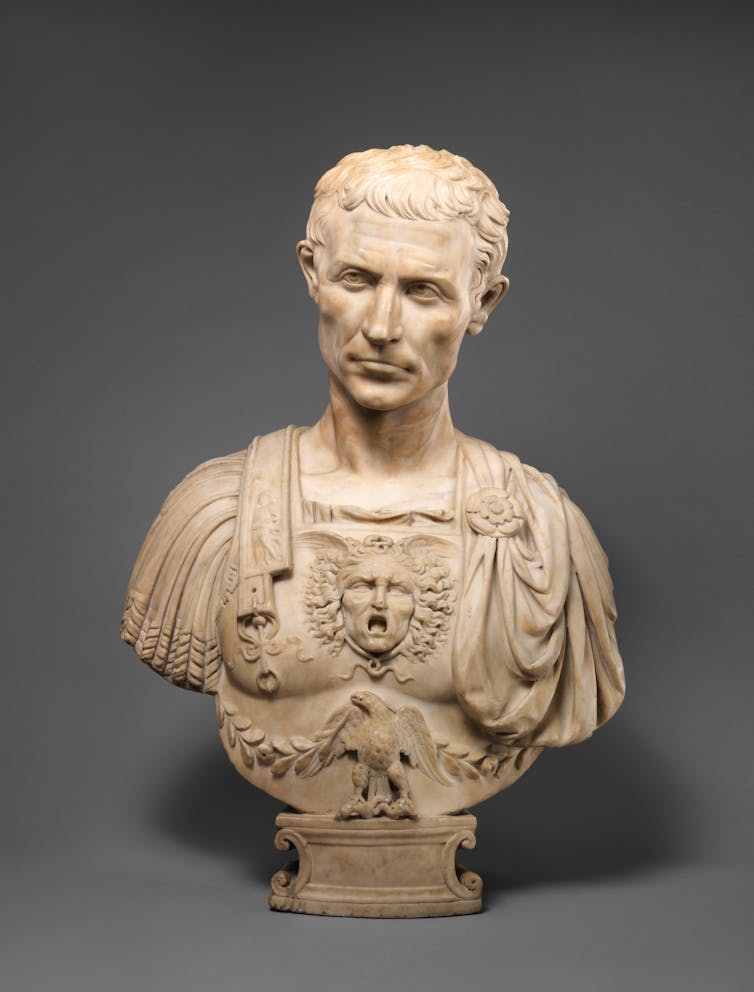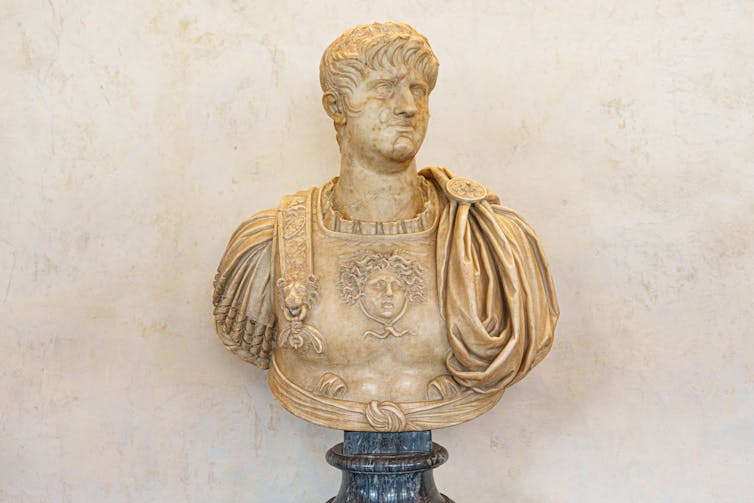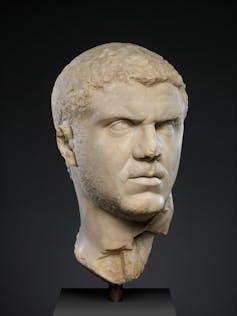Something tells me US president Donald Trump would love to be a Roman emperor. The mythology of unrestrained power with sycophants doing his bidding would be seductive.
But in fact, Roman emperors were heavily constrained by institutions, the economy and popular mood. Yes, some challenged and sidelined the institutions of their day – but this often sparked a powerful backlash.
As someone who’s studied Ancient Rome for years, I’ve recently been asked which Roman emperor was most like Donald Trump. In some ways he’s a pastiche of several Roman leaders.

AP Photo/Julia Demaree Nikhinson
Julius Caesar
Of course, Julius Caesar was never an emperor. He was a military leader and politician when the Roman Republic was in its death throes.
While Trump has no military experience, some have compared him with Caesar.
English classicist Mary Beard explains the appeal of this comparison for Trump’s foes and supporters alike.
The Roman Republic was originally a system of shared political authority. The Senate, the people and elected magistrates shared power.
But in the first century BC, powerful and charismatic figures became more prominent. The old power-sharing arrangements broke down.

Bequest of Benjamin Altman, 1913/The Metropolitan Museum of Art
Caesar was the most significant of these figures. He was the ultimate populist who overthrew the conventional means of Republican government. Due to his military successes, vast fortune and enormous popular appeal, Caesar broke the system entirely.
Caesar fast-tracked the development of executive power in one person. This doomed the Roman Republic itself.
Trump has also sidelined key institutions and increased the powers of singular executive government. Threatening judges and the chair of the Federal Reserve are further examples of over-reach.
Trump draws on popular appeal to escape ramifications for these actions. His TV career, political rallies and domination of the news cycle contribute to a cult of personality.
Caesar paid the ultimate price for concentrating executive power in himself. He was stabbed to death by a group of angry senators. The republic, however, was beyond saving.
Caesar and the Roman Republic were different to Trump and America. Caesar was a blue-blood patrician, which Trump isn’t. Rome had its most powerful centuries ahead of it, while America is in decline.
Octavian: the man who became Augustus
Caesar didn’t manage the transition from Republic to autocracy. It was his nephew, Octavian, who did that.
After more than a decade of civil wars following Caesar’s murder in 44 BCE, Octavian became Augustus (27 BCE–14 CE) or emperor.
While he claimed to restore the republic, Augustus exercised ultimate power over the army, political institutions and the courts. He finished the process Caesar and others began, dominating the Senate and once-powerful positions such as consulships.
Augustus’ domination of the entire political system draws parallels with Trump. Some observers liken Trump to Augustus. They see similarities in Trump’s intimidation of institutions (including the courts and media) that provide checks on presidential power.
Augustus also developed a cult of personality, which is a feature of Trump’s rise.
Nero: from populist to pariah
Nero (54–68 CE), a colourful successor of Augustus, employed advisors with no political backgrounds. Epaphroditus, for example, was a former slave who became Nero’s secretary. He controlled the flow of information to and from the emperor. He became very wealthy and was intensely loyal to Nero.
Trump has shown similar instincts. Think of the wide-ranging powers to cut government programs granted to Elon Musk and his inexperienced team.
Like Trump, Nero could entertain a crowd. He publicly sang and recited poetry, which previous emperors never did. The elites detested this but the broader population loved it. Nero also put on lavish palace banquets.
But by the time of his death by suicide aged 30, Nero had isolated everyone.
It’s too simplistic, though, to say Trump is a Nero, as others have done. Trump remains connected to a large support base, as evidenced by his two presidential election victories.

Ivan Moreno sl/Shutterstock
Roman emperors were constrained by institutions
While Roman emperors dominated the institutions of state, they were still constrained by them. Some who fell foul of the army, the most important state institution, met ignominious ends.
In 217 CE, the unpopular emperor Caracalla was knifed by a soldier while relieving himself.

Samuel D. Lee Fund, 1940/The Metropolitan Museum of Art
Emperor Severus Alexander was murdered in 235 CE by his own troops while clutching his mother’s knees.
Some speculate the US army might intervene to protect the Constitution against Trump. But the army’s relationship to the US government is more complex than in ancient Rome.
Some emperors became unpopular due to their arrogance toward the Senate, court officials and their own bodyguards.
In 96 CE, Domitian was killed in a conspiracy of the court chamberlain. His death was cheered by many due to his autocratic style.
And Emperor Commodus, once popular due to his eccentric antics and public games, was murdered by a champion wrestler in 192 CE. His mistress, Praetorian prefect and court chamberlain arranged it. The Senate declared Commodus a public enemy.
The creeping power of executive authority
The over-reach of executive authority will likely define Trump’s second term. But there are many constraints he can’t ignore. Some of the most powerful operate outside America. Bond-holders, of whom China is the second largest, are a notable example.
The eventual displeasure of support bases may hasten the demise of the Trump phenomenon. I sincerely hope it doesn’t end with the brutality some of the emperors met with.
Executive over-reach and intimidation of key institutions may permanently damage America’s reputation. In the case of ancient Rome, we know the outcomes. What comes next in America is the great unknown.




